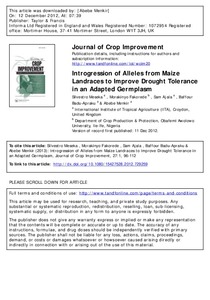| dc.contributor.author | Meseka, S.K. |
| dc.contributor.author | Fakorede, M.A.B. |
| dc.contributor.author | Ajala, S. |
| dc.contributor.author | Badu-Apraku, B. |
| dc.contributor.author | Menkir, A. |
| dc.date.accessioned | 2019-12-04T11:03:24Z |
| dc.date.available | 2019-12-04T11:03:24Z |
| dc.date.issued | 2013 |
| dc.identifier.citation | Meseka, S., Fakorede, M., Ajala, S., Badu-Apraku, B., & Menkir, A. (2013). Introgression of alleles from maize landraces to improve drought tolerance in an adapted germplasm. Journal of Crop Improvement, 27(1), 96-112. |
| dc.identifier.issn | 1542-7528 |
| dc.identifier.uri | https://hdl.handle.net/20.500.12478/1049 |
| dc.description.abstract | Maize (Zea mays L.) landraces in the northern Guinea savanna and Sudan savanna in West and Central Africa appear to have some drought-adaptive traits. This study was initiated to assess the level of improvement in yield potential and other agronomic traits achieved under drought stress (DS) and in multiple locations (ML) after introgression of alleles from maize landraces into an elite maize variety (AK9443-DMRSR) via backcrossing. Six backcross (BC) populations together with recurrent parent (AK9443-DMRSR), a commercial hybrid (Oba Super-II), and an improved variety (TZLCOMP4C1) were evaluated under controlled DS and full irrigation (FI) during the dry seasons of 1999 and 2000, as well as in seven ML trials. No significant differences were observed among genotypes for grain yield and most of the traits measured under DS and FI. Significant differences were recorded among genotypes for grain yield and other agronomic traits measured in ML and across 11 environments. Drought stress reduced grain yields of the BC1F2 populations by 64% and recurrent parent by 71%. In ML trials, at least half of the populations were better than recurrent parent. The top three BC1F2 populations produced more grains than the recurrent parent (258–360 kg/ha) and Oba Super-II (555–657 kg/ha) with introgression of only 25% genome of the landraces. We concluded that backcross procedure was able to transfer a quantitative trait of grain yield of an elite recurrent parent into maize landraces. Additional backcross generations are needed for improved performance of the BC1F2 populations in drought-prone environments. |
| dc.language.iso | en |
| dc.subject | Drought Tolerance |
| dc.subject | Maize |
| dc.subject | Germplasm |
| dc.subject | Introgression |
| dc.subject | Backcrossing |
| dc.title | Introgression of alleles from maize landraces to improve drought tolerance in an adapted germplasm |
| dc.type | Journal Article |
| dc.description.version | Peer Review |
| cg.contributor.crp | Maize |
| cg.contributor.affiliation | International Institute of Tropical Agriculture |
| cg.contributor.affiliation | Obafemi Awolowo University |
| cg.coverage.region | Africa |
| cg.coverage.region | West Africa |
| cg.coverage.country | Nigeria |
| cg.authorship.types | CGIAR and developing country institute |
| cg.iitasubject | Maize |
| cg.journal | Journal of Crop Improvement |
| cg.howpublished | Formally Published |
| cg.accessibilitystatus | Limited Access |
| local.dspaceid | 78047 |
| cg.identifier.doi | https://dx.doi.org/10.1080/15427528.2012.729259 |

